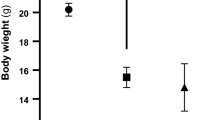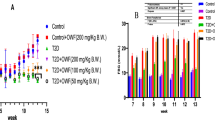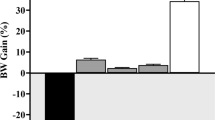Abstract
This study was designed to determine the protective effect of kefir on the oxidative damage, as well as histological and biochemical changes that occur in the kidney tissues of experimental diabetic rats. Forty rats were allocated into four groups as “healthy saline” (SF), “healthy kefir” (KF), and the same groups with experimentally induced diabetes (DSF and DKF). Diabetes was induced by administering 65 mg/kg single-dose streptozotocin. Oral kefir was given 10 ml/kg/day for 35 days to the rats in the groups KF and DKF. The same amount of saline was given to the groups SF and DSF. On the 36th day of the study, blood glucose, urea, and creatinine were measured besides glucose, creatinine, microalbuminuria, and sodium in the urine. Additionally, histological examination was performed on the kidney tissues. Blood glucose, creatinine, and urea levels were significantly lower in the DKF group compared with those of the DSF group (p < 0.001). Also, the creatinine level was significantly decreased (p < 0.001), and microalbuminuria was increased (p < 0.001) in the DKF group compared with that of the DSF group. Histologically, intermittent expansion in the renal glomeruli, reduction of cast formation in the tubules, and improvement in the renal epithelial tissues of the DKF group were observed. Kefir decreased the damage caused by diabetes. These results indicate that kefir supplementation may contribute to better control of oxidative stress, which is related to the improvement of renal functions, suggesting its use to slow down the progression of diabetic nephropathy.



Similar content being viewed by others

References
Fava S, Hadjadj S, Walker J (2014) Diabetic renal disease. Int J Endocrinol 2014:1–2. https://doi.org/10.1155/2014/598015
Wu J, Mei C, Vlassara H, Striker GE, Zheng F (2009) Oxidative stress-induced JNK activation contributes to proinflammatory phenotype of aging diabetic mesangial cells. Am J Physiol Physiol 297:F1622–F1631. https://doi.org/10.1152/ajprenal.00078.2009
Ha H, Lee HB (2001) Oxidative stress in diabetic nephropathy: basic and clinical information. Curr Diab Rep 1:282–287. https://doi.org/10.1007/s11892-001-0047-1
Hunt K, Ernst E (2010) Patients’ use of CAM: results from the Health Survey for England 2005. Focus Altern Complement Ther 15:101–103. https://doi.org/10.1211/fact.15.2.0005
Posadzki P, Lee MS, Ernst E (2012) Complementary and alternative medicine for diabetes mellitus: an overview of systematic reviews. Focus Altern Complement Ther 17:142–148. https://doi.org/10.1111/j.2042-7166.2012.01159.x
Mahmoudian SA, Babai ME, Jafari M (2012) The reasons for and satisfaction from using acupuncture in Isfahan. J Isfahan Med Sch 29(166):2280–2288 http://jims.mui.ac.ir/index.php/jims/article/download/1417/1838 Accessed 06 August 2020
Chiu L, Balneaves L, Barroetavena MC, Doll R, Leis A (2006) Use of complementary and alternative medicine by Chinese individuals living with cancer in British Columbia. J Complement Integr Med 3(1). https://doi.org/10.2202/1553-3840.1037
Barengolts E, Smith ED, Reutrakul S, Tonucci L, Anothaisintawee T (2019) The effect of probiotic yogurt on glycemic control in type 2 diabetes or obesity: a meta-analysis of nine randomized controlled trials. Nutrients 11(3):671. https://doi.org/10.3390/nu11030671
Ostadrahimi A, Taghizadeh A, Mobasseri M, Farrin N, Payahoo L, Beyramalipoor Gheshlaghi Z, Vahedjabbari M (2015) Effect of probiotic fermented milk (kefir) on glycemic control and lipid profile in type 2 diabetic patients: a randomized double-blind placebo-controlled clinical trial. Iran J Public Health 44(2):228–237 https://www.ncbi.nlm.nih.gov/pmc/articles/PMC4401881/
Li C, Li X, Han H, Cui H, Peng M, Wang G, Wang Z (2016) Effect of probiotics on metabolic profiles in type 2 diabetes mellitus: a meta-analysis of randomized, controlled trials. Medicine (Baltimore) 95(26):e4088. https://doi.org/10.1097/MD.0000000000004088
Hui YH, Meunier-Goddik L, Josephsen J, Nip W-K, Stanfield PS (2004) Handbook of food and beverage fermentation technology. CRC Press, Boca Raton. https://doi.org/10.1201/9780203913550
Kabak B, Dobson ADW (2011) An introduction to the traditional fermented foods and beverages of Turkey. Crit Rev Food Sci Nutr 51(3):248–260. https://doi.org/10.1080/10408390903569640
de Oliveira Leite AM, Miguel MAL, Peixoto RS, Rosado AS, Silva JT, Paschoalin VMF (2013) Microbiological, technological and therapeutic properties of kefir: a natural probiotic beverage. Braz J Microbiol 44(2):341–349. https://doi.org/10.1590/S1517-83822013000200001
Farnworth ERT (2003) Handbook of fermented functional foods. CRC press, Boca Raton. https://doi.org/10.1201/9781420053289
Kanbak G, Uzuner K, Kusat Ol K, Oglakci A, Kartkaya K, Senturk H (2014) Effect of kefir and low-dose aspirin on arterial blood pressure measurements and renal apoptosis in unhypertensive rats with 4 weeks salt diet. Clin Exp Hypertens 36(1):1–8. https://doi.org/10.3109/10641963.2013.783046
Osicka TM, Yu Y, Panagiotopoulos S, Clavant SP, Kiriazis Z, Pike RN, Pratt LM, Russo LM, Kemp BE, Comper WD, Jerums G (2000) Prevention of albuminuria by aminoguanidine or ramipril in streptozotocin-induced diabetic rats is associated with the normalization of glomerular protein kinase C. Diabetes 49(1):87–93. https://doi.org/10.2337/diabetes.49.1.87
Lang EJ, Tang T, Suh CY, Xiao J, Kotsurovskyy Y, Blenkinsop TA, Marshall SP, Sugihara I (2014) Modulation of Purkinje cell complex spike waveform by synchrony levels in the olivocerebellar system. Front Syst Neurosci 8. https://doi.org/10.3389/fnsys.2014.00210
Nalbantoglu U, Cakar A, Dogan H, Abaci N, Ustek D, Sayood K, Can H (2014) Metagenomic analysis of the microbial community in kefir grains. Food Microbiol 41:42–51. https://doi.org/10.1016/j.fm.2014.01.014
Hall JE, Guyton AC (2006) Textbook of medical physiology. Elsevier Health Sciences
Barrett KE, Barman SM, Boitano S, Brooks HL (2016) Ganong’s review of medical physiology. McGraw Hill Education
Laiken ND, Fanestil DD (1985) Body fluids and renal function. In: West JB (ed) Best and Taylor’s physiological basis of medical practice, 11th edn. Williams and Wilkins, Baltimore, pp 438–543
Yadav H, Jain S, Sinha PR (2008) Oral administration of dahi containing probiotic Lactobacillus acidophilus and Lactobacillus casei delayed the progression of streptozotocin-induced diabetes in rats. J Dairy Res 75(2):189–195. https://doi.org/10.1017/S0022029908003129
Hadisaputro S, Djokomoeljanto RR, Soesatyo MH (2012) The effects of oral plain kefir supplementation on proinflammatory cytokine properties of the hyperglycemia Wistar rats induced by streptozotocin. Acta Med Indones 44(2):100–104 https://pubmed.ncbi.nlm.nih.gov/22745139/
Al-Salami H, Butt G, Fawcett JP, Tucker IG, Golocorbin-Kon S, Mikov M (2008) Probiotic treatment reduces blood glucose levels and increases systemic absorption of gliclazide in diabetic rats. Eur J Drug Metab Pharmacokinet 33:101–106. https://doi.org/10.1007/BF03191026
Punaro GR, Maciel FR, Rodrigues AM, Rogero MM, Bogsan CSB, Oliveira MN, Ihara SSM, Araujo SRR, Sanches TRC, Andrade LC, Higa EMS (2014) Kefir administration reduced progression of renal injury in STZ-diabetic rats by lowering oxidative stress. Nitric Oxide 37:53–60. https://doi.org/10.1016/j.niox.2013.12.012
Lin C-H, Lin C-C, Shibu MA, Liu CS, Kuo CH, Tsai FJ, Tsai CH, Hsieh CH, Chen YH, Huang CY (2014) Oral Lactobacillus reuteri GMN-32 treatment reduces blood glucose concentrations and promotes cardiac function in rats with streptozotocin-induced diabetes mellitus. Br J Nutr 111(4):598–605. https://doi.org/10.1017/S0007114513002791
Tonucci LB, Dos Santos KMO, de Oliveira LL, Ribeiro SMR, Martino HSD (2017) Clinical application of probiotics in type 2 diabetes mellitus: a randomized, double-blind, placebo-controlled study. Clin Nutr 36(1):85–92. https://doi.org/10.1016/j.clnu.2015.11.011
Moroti C, Magri LFS, de Rezende CM, Cavallini DCU, Sivieri K (2012) Effect of the consumption of a new symbiotic shake on glycemia and cholesterol levels in elderly people with type 2 diabetes mellitus. Lipids Health Dis 11:29. https://doi.org/10.1186/1476-511X-11-29
Kayali R, Telci A, Cakatay U, Karaca C, Akcay T, Sivas A, Altug T (2003) Oxidative protein damage parameters in plasma in chronic experimental diabetes in rats. Eur J Med Res 8(7):307–312 https://pubmed.ncbi.nlm.nih.gov/12911868/
Cakatay U, Telci A, Salman S, Satman L, Sivas A (2000) Oxidative protein damage in type I diabetic patients with and without complications. Endocr Res 26(3):365–379. https://doi.org/10.3109/07435800009066174
dos Reis SA, da Conceição LL, e Dias MM et al (2019) Kefir reduces the incidence of pre-neoplastic lesions in an animal model for colorectal cancer. J Funct Foods 53:1. https://doi.org/10.1016/j.jff.2018.11.050
Karabacak P, Solmaz FA, Gultekin F et al (2016) The effectiveness of kefir in acute renal failure due to glycerol-induced rhabdomyolysis. Int J Clin Exp Med 9(9):17919–17925 http://www.ijcem.com/files/ijcem0027784.pdf Accessed 06 August 2020
Funding
This study was supported by Çanakkale Onsekiz Mart University Scientific Research Projects Coordination Unit. Project Number: 2014-TYL-183.
Author information
Authors and Affiliations
Corresponding author
Ethics declarations
Conflict of Interest
The authors declare that they have no conflict of interest.
Additional information
Publisher’s Note
Springer Nature remains neutral with regard to jurisdictional claims in published maps and institutional affiliations.
Rights and permissions
About this article
Cite this article
Kahraman, M., Ertekin, Y.H. & Satman, İ. The Effects of Kefir on Kidney Tissues and Functions in Diabetic Rats. Probiotics & Antimicro. Prot. 13, 375–382 (2021). https://doi.org/10.1007/s12602-020-09698-9
Published:
Issue Date:
DOI: https://doi.org/10.1007/s12602-020-09698-9



